“A TRIO OF SPECIAL TREATS” – by Des Kelly
Sent in by my good friend and Encyclopaedic-Entrepeneur-
Extraordinaire, Victor Melder.
Thank you very much Victor.
I salute you, as a true Legend of Sri Lanka.
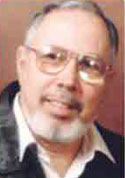
Desmond Kelly.
(Editor-in-Chief) e’Lanka.
A visionary garden designed with such care
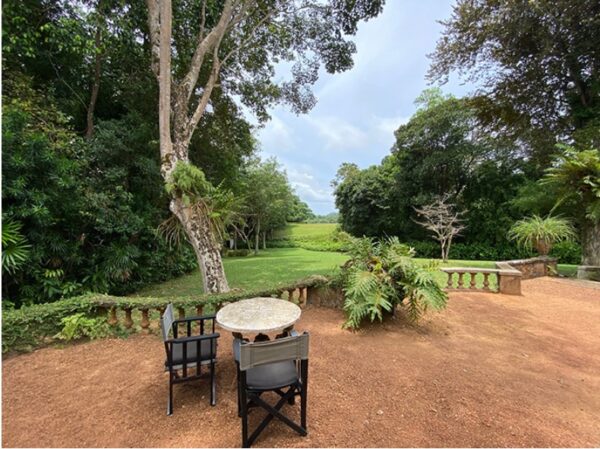
Source:Island
Green in all its brilliant shades; vast undulating open spaces; clumps of trees; water to be seen and a distant white dagoba. Peace and absolute serenity and excellent service with the helpers showing concern and sincerely desiring to please. All this and more during a weekend spent in a famous garden. There were four of us
 staying over in the bungalow which is now a superb boutique hotel. Two occupied rooms in the main house while my son and I were in the Gatehouse on the upper floor with a wide, wide glass window and the rear of the large room a dressing area leading to a superbly fitted bathroom with a bathtub and also shower area.
staying over in the bungalow which is now a superb boutique hotel. Two occupied rooms in the main house while my son and I were in the Gatehouse on the upper floor with a wide, wide glass window and the rear of the large room a dressing area leading to a superbly fitted bathroom with a bathtub and also shower area.
I had previously walked around this garden which is a showpiece of pride to our country, with my son explaining each piece of it and sat in the verandah of the house which too he gave the history of, and much more. But this was my first relaxed overnight stay. I soaked in the solitude; the unbroken stretches of nature; the vistas at dawn, midday, dusk with twilight gently descending. The moon illumined the wide verandah of the house and lawns giving an entirely different perspective.
We had our meals out in the garden of the main house, in the different locations the owner would breakfast, lunch and dine in. Breakfast was on the front entry terrace of the house; lunch in a corner of the garden and dinner on the north terrace with lights glimmering in the distance. Most of the dishes served were what the owner would have had. Our lunch after arrival was rice and curry. Dinner offered a choice of fish prepared in two ways or chicken, pasta and homemade bread. Breakfast meant hot, hot hoppers with spicy accompanying curries.

The Place
The weekend was spent at Lunuganga; me with three architects: well known, C Anjalendran who had worked with Geoffrey Bawa and then served as his unpaid assistant for 20 years, spending most weekends at Lunuganga with the great man. The other – my architect son, an ardent admirer of Bawa; and a young, just graduated architecture student. Thus it was a unique two days, not only staying in a special place but with interesting conversations and introductions by Anjalendran to the history and evolution of Lunuganga. Many were informal conversations with nuggets of information and memories narrated; but one was a proper lecture with all the staff invited to it. Thus we got to know anecdotes, character traits of Geoffrey Bawa and his brother Bevis too, and how this special place came into being.
History of Lunuganga
In January1948, the year his mother died, Geoffrey Bawa (1919 -2003) bought a neglected rubber plantation a few miles interior to Bentota. Upon first sight of the land, Bawa knew for sure it could be made the garden he had created in his mind. He had returned from Cambridge with a Tripos in English, but design and architecture were what his intellect drove him to. His brother Bevis had already designed and constructed his garden residence – Brief – also in Bentota, in 1938.
Anjalendran had a long tale to tell about the purchase of the rubber estate which meant buying and building in a sort of musical chairs enactment, music being substituted with coaxing, promises and money. The estate was the dowry endowment of a lady living in Bentota. She had rented the then dilapidated house to the tax officer of the area. He said he would budge only if he got possession of a house in Bentota occupied by another government servant. This latter gent agreed to move if he got possession of the schoolmaster’s house down by the sea. Hence Bawa approached this last person. He said he would vacate his house if a new one was built for him. Thus the building of this house resulted in Geoffrey Bawa finally becoming the owner of the 15-acre rubber estate after “controlled patience and determination and occasional bouts of despair.”
He wrote to friend Jean Chamberlain, “When I had first seen Lunuganga I had known that with a first few clearings of trees and opening up of obvious vistas an inevitable basic pattern would emerge. It was enormously exciting, and the morning after the dramatic breaking of walls and the feel of possession, the adventure began and adventure that has lasted 40 years and the pleasure of which has never palled.”
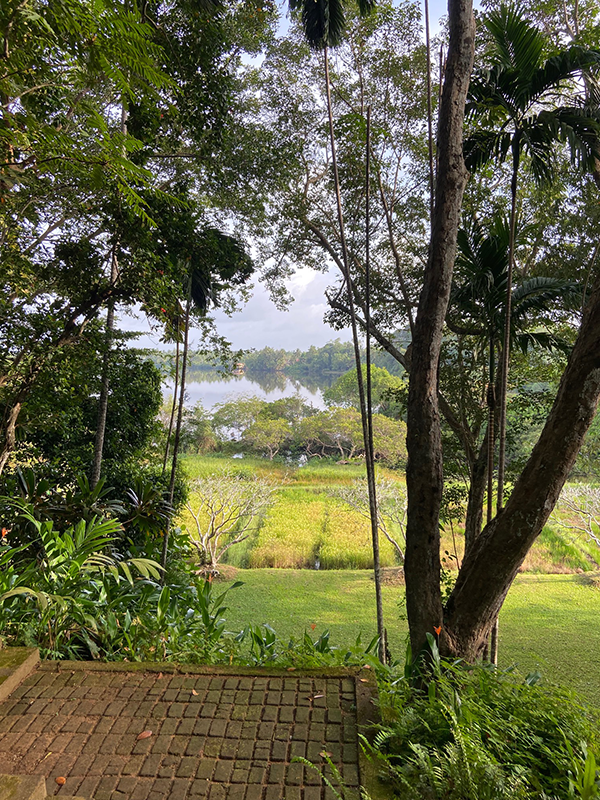
The old house was completely renovated and reoriented with the back becoming the front. Various buildings were added over time as the garden was being reshaped. Today the property is under the care of the Geoffrey Bawa Trust and operated impeccably as a boutique hotel by Teardrop Hotels. Many of the staff have been at the property for a decade or more.
Pointing to the verdant island in the middle of Dedduwa Lake beside which Lunuganga stretches, Anjalendran said that it was a belief propagated by temple lore that the restless spirit of a long dead monk lived in a tree on the island. Maybe he turned a benign eye on the new owner of the land as he started creating his heart’s desire of a unique garden. Ulrik Plesner, Bawa’s early collaborator in the 1960s, was a constant visitor and offered suggestions. To improve views, the land was meticulously ‘structured’ with massive earthworks, transport of soil and depositing it elsewhere so that the present slightly terraced slopes were achieved. Trees were studiedly left standing or cut down. Cinnamon Hill seen from the back of the house was lowered so that a sliver of lake at the far end could be seen. Marvelously, the distant view was interrupted but enhanced by placing a large jar at a spot under a Moonama tree. As Plesner writes “By placing a big old Portuguese jar under an old tree in the middle distance, several square kilometers of lagoon and jungle and even the temple itself have been drawn into the garden. It is strange how one can civilize a whole landscape with a single pot.”
I quote from the monograph Lunuganga published by Geoffrey Bawa with Christoph Bon and Dominic Sansoni in the late 1980s. “Bawa continued to shape and change Lunuganga until the very end of his practice; even when he was taken ill and immobile. In fact, he continued to spend time in the gardens even in the final stages of his life; and the soothing qualities of the place prevail even today. It is both an ever-transient place and one where time stands still; a subtle change in the position of the sun or the direction of the wind will completely change the dance of leaves at Lunuganga and its entire atmosphere. Yet it feels as though the gardens have always been there, we feel assured that it will remain.”
Though confined to a wheel chair after his first stroke, Bawa undeterred, went daily around the garden, pointing out work that had to be done like lopping off view obstructing branches of trees.
On our return to Colombo we dropped by at Brief, built by Bevis Bawa modeled on French and British palace gardens. The contrast between the two gardens, to even a novice like me, was obvious. One is conventional, with ordered lawns, discrete outdoor rooms and terraced flower beds, the other seemingly wild yet carefully planned, stark yet lush. The only flower ‘allowed’ at Lunuganga seems to be frangipani. The very old tree right in front of the verandah which has thick branches almost grazing the ground had shed its leaves and its white flowers too were few and far between. Bawa had deliberately moulded the tree by placing weights on its lowest branches so they grew horizontally, almost touching the earth before rising higher.
Two quoted remarks made to Geoffrey Bawa sums up the varied reactions to the place from puzzlement to contentment and appreciation. A city dwelling woman had commented to Bawa on seeing Lunuganga for the first time: “This would be a lovely place to have a garden.” In contrast, a lorry driver who had arrived to unload bricks said: “Meka Nam Hari Seedevi Thenak!”
Carlyle Perera : Doyen of University Cricket-by Merril Gunaratne
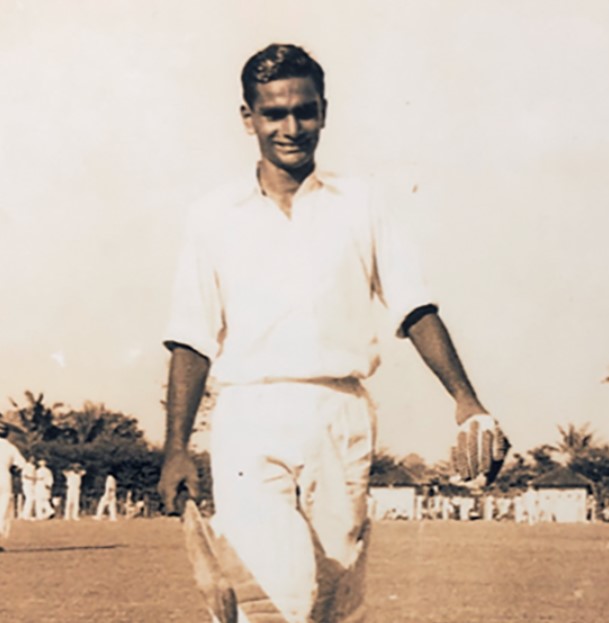
Source:Island
Dr.Carlyle Perera of St Joseph’s College and University of Ceylon who died a few days ago was a gifted cricketer, well known in cricket circles in the 1950’s and 60’s. He left his imprint on University cricket by winning the Saravanamuttu cricket trophy in 1962-63. It was a unique achievement, for not only did he wrest the trophy from the monopolistic control of established clubs, but also created a record by achieving a feat unrivaled before or after by the University.
Carlyle reached such dizzy heights with a band of exceptionally talented schoolboy cricketers who had gained admission to the University. It was an era when cricket was more a pastime than a full time commitment. But a change came after the country received Test status. Cricket was earlier played to give expression to passion and enjoyment, to evoke praise and appreciation for display of talent, and to gain recognition. Money was yet to enter the picture. Therefore, before the transition in the divide, with nothing but recognition being the only reward or compensation for excellence, schoolboy cricketers often sought to secure their future by commitment to studies. Others looked for gainful employment to face future challenges of life.
Two examples come to mind. L.R. Gunatillake, the speedster in the 1950’s and 60’s, was arguably one of the best fast bowlers, if not the very best, to have graced the national scene. But at the summit of success, he opted for employment out of Colombo. His loss was also the country’s loss. It was therefore a period when more time was spent on studies and gainful employment, and less on cricket. Stability of the future and a rewarding profession or means of income predominated time and exertions required for the game.
On the other side of the divide when money came to influence the game, cricket as a discipline became highly challenging and competitive. Therefore, considerable time had to be devoted for practices and matches. Inevitably, cricket became both a passion and a serious profession. With more devotion to the game, there was less time for studies or practicing professions seriously. Those who carved big names, were amply compensated, for cricket was more lucrative than employment. Kumar Sangakkara epitomised the period after the transition. He was equipped to emerge as an eminent lawyer, but wisely preferred to devote time to his exceptional skills in cricket, to emerge as one of the best batsmen in the world. He therefore gained both opulence and fame.
The University was blessed with a galaxy of outstanding cricketers in the 1950’s and 60’s. But they epitomized the breed before the divide or the transition. They spent more time on studies, and less on the game, to prepare for the challenges of life. One could only conjecture how they would have performed after the transition, amidst attractive enticements. Scarcity of space constrain a narrative of a large number of names that come to mind, but at least some of them deserve mention; Carlyle Perera, HIK Fernando, DH De Silva, Buddy Reid, Brendon Gooneratne, Mano Ponniah, Lareef Idroos, Ranjit Doranegama, Cyril Ernest, Nihal Gurusinghe, Raja De Silva, Priya Perera, Neil Chanmugam, Mohanlal Fernando, Kingsley Fernando, Skandakumar, Malsiri Kurukulasooriya, Anton Rambukpota, Michael Roberts, Sarath Wimalaratne and Sarath Seneviratne. There were many more. The list would be endless.
To my recollection, University of Ceylon came third in the “Sara” trophy tournaments of 1960-61 and 1961-62. Carlyle Perera was the vice captain in 1961-62 to Brendon Gooneratne. Mano Ponniah, Lareef Idroos, Cyril Ernest, Kingsley Fernando, Harsha Samarajiva, NJS de Mel and Sivanandan, well known for their prodigious feats as schoolboys, entered the University in 1961-62.
Carlyle Perera took over the reins of leadership in 1962-63. He had lost reputed seniors from the team of the previous year: Brendon Gooneratne, Priya Perera and Neil Chanmugam amongst others. I too had opted out of cricket to prepare for the final exam, since travelling to and from Peradeniya disturbed preparations for the exam. I however played just one match, against the SSC, on a request from Carlyle to try and capture the wicket of Ivers Gunasekara, having done so thrice previously. Carlyle led the relatively raw, untested team to the pinnacle of success, and carved an indelible niche in the annals of University cricket by winning the championship trophy. Buddy Reid was the ideal vice captain to him, both working “in tandem”.
The performances of established players, Buddy Reid, Nihal Gurusinghe, URP Gunatillaka, Mohanlal Fernando, Ernest and Idroos were not exactly outstanding in the previous year. Besides, players of the calibre of Ponniah, Idroos, Nanda Senanayake, Samarajiva, Ernest and Kingsley Fernando did not acquire permanent positions in 1961-62. Perhaps the senior players could not be omitted to make way for them, or their talent and potential had not been fully recognized and harnessed.
Carlyle as captain transformed them from good players to “giants”. Reid, Ponniah, Gurusinghe, Ernest, Nanda Senanayake, NJS de Mel, URP Gunatillake and Kingsley Fernando scored heavily, whilst the three all rounders, Idroos , Ernest and Mohanlal Fernando excelled with both bat and ball. Mohanlal had been my opening bowling mate in the previous years, but bowling with venom and hostility, he was an entirely different bowler in 1962-63 under the inspiring leadership of Carlyle. All rounders Mohanlal Fernando, Idroos and Ernest excelled consistently to be the envy of many clubs, for it was uncommon for them to boast of such a luxury of gifted allrounders. The prodigious performances of Reid, Mohanlal Fernando, Idroos , Ponniah, Ernest and Nihal Gurusinghe were rewarded, with all of them being selected to represent either Ceylon or C.C.A. (Ceylon Cricket Association). Ponniah proceeded to Cambridge and performed with panache, partnering Mike Brearley as opener.
On assuming the captaincy, Carlyle set himself the target of becoming champions in the tournament, and drilled his team to work towards it. He requested his players to abandon their carefree approach to the game, spend more time at practices despite studies, regain fitness, and practice fielding intensely. He infused confidence in each and every player. He made them trust their yet hidden, untapped potential. He changed the mindset of his players by constantly coaxing them to perform better. He dangled the carrot and wielded the stick, and made the team a cohesive, well knit team. As matches progressed, performances prospered and confidence abounded, the team developed a type of fighting spirit alien to many competing clubs. They often fought tooth and nail to wriggle out of situations. Carlyle converted a relatively untested group of players to a formidable outfit which became the cynosure of adoring spectators.
The players reached a point in thinking that they could surmount any challenge. It is not often that a group of players which made a modest impact in the previous year, could emerge as “greats” within just one year; and for some of them to gain national recognition. Carlyle had no material benefits to offer to bait his players but only words of inspiration, sincerity, and exemplary leadership. He was yet a mere student amongst students. He was also a martinet, but only when necessary. Carlyle’s inestimable worth as a leader was confirmed by the inability of the University to reach “cup glory” before 62-63 or after.
He was also skilful in tactics and strategy, working in concert with Buddy Reid. They meticulously sat and planned tactics against opposition batsmen and bowlers before each match. Carlyle’s obsession and unwavering commitment influenced the entire team. It was as if he had cast a benevolent spell over his players. Carlyle was in actual fact, captain, coach and manager of the side, blending all roles into one. He found his true metier in leadership, planning strategies, and management. Posterity has to recognize Carlyle Perera as the undisputed doyen of University cricket, for his unique achievement will remain an undimmed beacon in it’s history.
Writer can be contacted at mmgunaratne@gmail.com
TWO FAMOUS COLLECTIONS OF CEYLON STAMPS-By Hugh Karunanayake
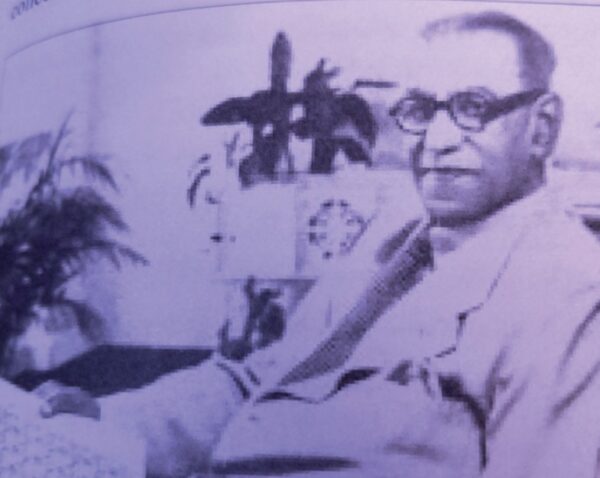
Source:Island
The collection of stamps as a hobby commenced with the issue of the “Penny Black” in Britain in the mid nineteenth century and rapidly expanded into the colonies of the British Empire and to the other major metropolitan powers of the world such as France, Portugal, Spain, and the USA. Britain during the reign of Queen Victoria, was acquiring the best of the products and cultures of its far flung empire. The purchasing power of its wealthy squires encouraged the pursuit of leisure time interests which included the new found hobby of stamp collecting.
The first postage stamp to be issued in Ceylon was in the six pence denomination – it was issued on April 1, 1857, seventeen years after Britain issued the first adhesive postage stamp in the world, the unperforated “Penny Black” released on May 6, 1840. The first Ceylon stamp was recess printed on blued paper with the ‘star’ watermark and bore the left profile of the head of Queen Victoria on an oval backdrop and its colour was purple brown.
From then onwards several more Ceylon stamps of the penny series in the imperforate as well as perforated type, were released over the years until 1872 when the country adopted the decimal currency and switched over to rupees and cents. The most expensive and difficult to obtain stamps for latter day collectors, were those released in the penny series and are of the 1d,2d,4d,5d,8d,9d,10d,1s, 1s9d,and 2s denominations.
There were four basic designs in the first set of imperforates which included octagonals. The 4d dull rose octagonal stamp is regarded as the rarest and most expensive of all Ceylon stamps. The rarest and most valuable collections of Ceylon stamps are those which have a good representation of penny series stamps.
There have been several outstanding collections of Ceylon stamps auctioned over the years. Harmers of London have been the auctioneers for most of the well known collections which included the Baron Anthony Worms Collection auctioned in June 1938, the Ernest B Lye Collection auctioned on May 8 1946 by Robson Lowe, the Rear Admiral Frederic Harris Collection auctioned on February 10/11 1953 by Harmers of New York, the Sir Ernest de Silva Collection auctioned on January 12/13 1959, the R.C Agabeg collection auctioned on May 20, 1982, the P.C. Pearson Collection auctioned on April 13 1983, and an unnamed collection auctioned on June 12 1984.Of the collections that have come on the market over the past 150 years two stand out as unique and remarkable both for the quality of the listings as well as their diversity. The two collections are those of Baron Anthony de Worms, and Sir Ernest de Silva.
Baron Anthony de Worms was born on January 4, 1869. He was the son of the first Baron Solomon de Benedict de Worms who was born in Frankfurt but was taken to England by his parents at an early age, and eventually went to Ceylon. Baron Solomon’s father was Benedict de Worms who was married to Janette the eldest sister of Baron de Rosthchild, the renowned banker and international financier. His two younger brothers Gabriel and Maurice de Worms who also moved to Ceylon were pioneers in plantation development in Ceylon in the mid 19th century. The brothers opened up thousands of acres of coffee plantations which after the failure of coffee by blight, were subsequently planted with tea.
Rothschild Estate, Sogama Estate in Pussellawa and Condegalla and Labookelle Estates in Ramboda were all originally cleared of jungle and planted in coffee by the de Worms brothers. Although the First Baron Solomon’s stay in Ceylon was brief in comparison to the more than two decades spent in the country by his younger brothers Gabriel and Maurice, it was he who inspired the interest in Ceylon stamps by his son Anthony.
The latter started with the usual schoolboy collection of stamps and that was augmented considerably when his father presented him with his collection of stamps which included many of the star watermarked penny issues. His uncles on the family estates in Ceylon continued to send him fine mint specimens of stamps which went to form the nucleus of his later magnificent collection on Ceylon.
With a rapidly increasing enthusiasm for his hobby Anthony was to acquire two reputed collections that of C.J. Daun and W.B. Thornhill. At the time of his death on January 11, 1938, Anthony de Worms was the owner of the finest collection of Ceylon stamps in the world. It included nine stamps of the imperforate 4 d dull rose including a pair, and a magnificent mint copy said to be the finest known copy of this rare stamp. An unused copy of the imperforate 4d dull rose is today priced at US$20,000.
There were only 7,400 copies of the stamp printed in 1857 The executors of his estate auctioned the collection through a four day sale on 20, 21, 22 and 23 June 1938 at which 880 lots were placed on sale by Harmers of London. The first 20 minutes on the second day of the auction when the 4 d stamps were being auctioned, was broadcast by the British Broadcasting Corporation; such was the keen interest shown in the auction.
The auction catalogue was constrained to express regret at seeing such a magnificent collection broken up. The cream of the Anthony de Worms collection was bought by a 50- year old philanthropist from Ceylon, Albert Ernest de Silva who was later to become Sir Ernest de Silva.Born on 26 November 1887, Sir Ernest de Silva had taken to stamp collecting at an early age as a student of Royal College in Colombo. He was the son of A.E. de Silva (Snr) a wealthy estate owner and exporter of tea, plumbago, cinnamon and coconut produce, who resided in a large mansion in Flower Road, Colombo, called “Stephanotis”.
Sir Ernest had his tertiary education in Cambridge University and upon his return he renamed his father’s home which he inherited, to “St Clare” after his college in Cambridge. Not long afterwards he built a magnificent home named “Srimathi-paya” also on Flower Road in which he resided up to his death. This house was later acquired by the government to serve as the office complex of the Prime Minister.
Sir Ernest was a gifted entrepreneur and within a few years of his return to Ceylon he expanded his broad acreages by acquiring more estates into the already burgeoning portfolio inherited from his father. He was the first Chairman of the Bank of Ceylon, a position he held up to his death in 1957. He was also the Chairman of the State Mortgage Bank, and was well known for his munificence and philanthropy. He was a great patron of the turf, owned a string of horses, and was the donor of the A.E. de Silva Trophy, a highly coveted trophy in the annual racing calendar. In the 1940s he was named the wealthiest man in Ceylon.
Sir Ernest attended the Anthony de Worms auction in London and bought the cream of the collection including many of the highly prized 4d dull rose specimens. As the most comprehensive Ceylon penny stamp auction ever, the De Worms auction attracted keen prospective buyers from all corners of the globe, but Sir Ernest was able to outbid the competition and returned home with a stunning addition to his stamp collection.
The outstanding items in the De Worms collection were featured in colour in the catalogue Of the 20 lots shown in colour, at least eight lots in addition to the many other stamps he purchased at the auction, were bought by Sir Ernest. Images of some of these stamps appeared once again, this time in the catalogue released 21 years later when Sir Ernest’s stamp collection was auctioned by Harmers of London.
Sir Ernest died on May 9, 1957, and the executors of his estate auctioned his stamp collection in a two day sale on Januar 12 and 13, 1959. Stamps that were sold at that auction have since found their way into many collections. Catalogues of stamp auctions over the past 50 years have occasionally described the provenance of a listed stamp as “Ex de Worms” or “Ex Sir Ernest de Silva” , a description that often added value to the item offered.
The outstanding stamp in both collections was a mint specimen of an imperforated four penny dull rose issued in 1857. This stamp was first sold in the De Worms auction of 1938 and bought by Sir Ernest de Silva. In the 1959 auction of Sir Ernest de Silva’s collection, this stamp was estimated at a price of £900. Fifty years later this stamp was featured once again as the crown jewel in the Joseph Hackmey collection auctioned in New York on February 18, 2009.The estimated catalogue price was US$ 200,000. An image of the stamp in colour was featured in the front cover of the de luxe auction catalogue issued by Spink Shreves Galleries, New York, who conducted the auction.
The 77-year old Joseph Hackney is one of the world’s foremost collectors of fine art, stamps, antiques, and rarities, and his name is listed in the global ‘rich list’among the 300 richest people alive. He employs a full time curator to maintain his collections which include priceless paintings of artists such as Van Gogh, Gauguin, and the impressionists. He is said to have commenced his Ceylon stamp collection in 1980, and over the past 40 years had built up an award winning philatelic collection covering many countries.
Many of the outstanding stamps in the De Worms and De Silva collections were ultimately acquired by Hackney. With the disposal of the Hackmey collection we witness once again a fragmentation of an assiduously gathered repository of philatelic history of Ceylon. Interestingly enough the only Sri Lankan to possess a collection of Ceylon stamps of international renown was Sir Ernest de Silva, both De Worms and Hackmey being of Jewish ethnicity. Despite the fact that stamp collecting is now served by a highly commercialised support industry and is also seen as a lucrative investment option, there is no indication that there will ever be any collection of Ceylon stamps that will surpass those of Baron Anthony de Worms and Sir Ernest de Silva.







